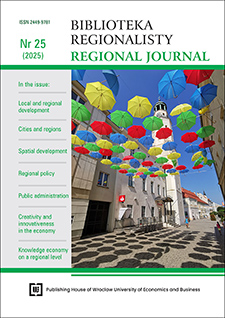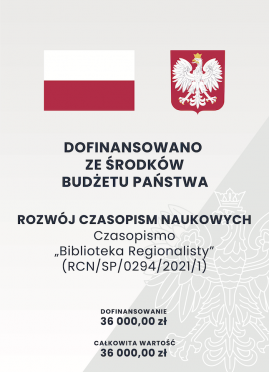Population changes in the vicinity of Wrocław in 1988-2021 as an expression of the formation of the urban functional area
DOI:
https://doi.org/10.15611/br.2025.1.12Keywords:
Wrocław, functional urban area, suburbanisation, regional and local developmentAbstract
Aim: The purpose of this article is to diagnose the process of formation of the Wroclaw urban functional area, in particular the suburban zone, which is the strict hinterland of the metropolitan centre, and to determine the extent of this zone.
Methodology: The research used cartographic analysis, relying on population data for Wroclaw and the neighbouring areas from the national census conducted in 1988, 2002, 2011 and 2021.
Results: The research showed that the contemporary suburban zone of Wroclaw, designated as an area covered by suburbanization processes, emerged only after 1988, with its extent not coinciding with the urban functional area designated in official strategic and planning documents.
Implications and recommendations: The results of the study suggest the desirability of delimiting the Wrocław Urban Area covering Wrocław and the suburban zone strictly adjacent to the city, which requires a special approach in development policy, different from that for the other parts of the broad Wrocław Functional Area. It also seems justified to deepen the research in order to delimit the Wrocław suburban zone more precisely and to consider changes in the administrative division.
Originality/value: All analyses to date aimed at delimiting the urban functional area of Wrocław (as well as other metropolitan centres in Poland) have been based on aggregate statistical data aggregated by municipality. This article presents an attempt to delimit the suburban zone on the basis of more detailed data concerning individual localities. As a result, the zone thus delimited is territorially smaller but internally more homogeneous.Downloads
References
Czyż, T. (2009). Koncepcja aglomeracji miejskiej i obszaru metropolitalnego w polskiej geografii miast. In W. Maik (Ed.), Aglomeracje miejskie w Polsce na przełomie XX i XXI wieku. Problemy rozwoju, przekształceń strukturalnych i funkcjonowania (pp. 15-30). Wyższa Szkoła Gospodarki w Bydgoszczy.
Eberhardt, P., Gontarski, Z., & Siemiński, J. (1973). Koncepcje delimitacji aglomeracji miejskich w Polsce. Aglomeracje miejskie w Polsce. Pojęcie i terminologia. Biuletyn KPZK PAN, (79), 187-217.
Friedmann, J., & Miller, J. (1965). The Urban Field. Journal of the American Institute of Planners, (31), 312-320.
Grochowska, A. (2016). Konflikty przestrzenne w planowaniu przestrzennym obszarów metropolitalnych na przykładzie Wrocławskiego Obszaru Metropolitalnego. Rozprawy Naukowe Instytutu Geografii i Rozwoju Regionalnego 38, Uniwersytet Wrocławski.
Korcelli, P. (1976). Aglomeracje miejskie w systemach osadniczych. Przegląd Geograficzny, 48(4), 589-598.
Korcelli, P. (2011). Obszary metropolitalne a funkcjonalne obszary miejskie. In S. Kaczmarek (Ed.), Miasto. Księga jubileuszowa w 70. Rocznicę urodzin Profesora Stanisława Liszewskiego (pp. 43-50). Wydawnictwo UŁ.
Korenik, S. (2001). Strategia integracji gospodarczo-przestrzennej aglomeracji wrocławskiej. Studia nad rozwojem Dolnego Śląska, 1(44), 27-30.
Königlichen Statistischen Bureau. (1874). Die Gemeinden und Gutsbezirke der Provinz Schlesien und ihre Bevölkerung. Verlag des Königlichen Statistischen Bureaus.
Liszewski, S. (1987). Strefa podmiejska jako przedmiot badań geograficznych. Próba syntezy. Przegląd Geograficzny, 59(1-2), 65-79.
Łoboda, J. (1992). Funkcjonowanie i delimitacja Wrocławia. Acta Universitas Lodziensis, Folia geographica, 17, 121-135.
Maleszka, W., & Szmytkie, R. (2009). Zmiany ludnościowe w strefie podmiejskiej Wrocławia. In W. Kamińska, & M. Mularczyk (Eds.), Współczesne procesy urbanizacji obszarów wiejskich (pp. 19-34). Uniwersytet Humanistyczno-Przyrodniczy Jana Kochanowskiego w Kielcach.
Markowski, T., & Marszał, T. (2006). Metropolie. Obszary metropolitalne. Metropolizacja. Problemy i pojęcia podstawowe. Polska Akademia Nauk, Komitet Przestrzennego Zagospodarowania Kraju.
McKenzie, R. D. (1933). The Metropolitan Community. McGraw-Hill.
Miszewska, B. (1985). Przemiany morfologiczne osadnictwa wiejskiego w strefie podmiejskiej Wrocławia. Metoda analizy. Folia Geographica, Acta Universitatis Lodziensis, 5, 103-122.
Miszewska, B. (1986). Morphologische Wandlungen laendlicher Siedlungen in der Vorortzone von Wrocław. Wissenschaft. Mitt., 20, 73-84.
Śleszyński, P. (2013). Delimitacja Miejskich Obszarów Funkcjonalnych stolic województw. Przegląd Geograficzny, 85(2), 173-197.
Śleszyński, P. (2014). Delimitation and Typology of Functional Urban Regions in Poland Based on Commuting, 2006. Geographia Polonica, 87(2), 317-320.
Śleszyński, P. (2015). Problemy delimitacji Miejskich Obszarów Funkcjonalnych w Polsce. Rozwój Regionalny i Polityka Regionalna, (29), 37-53.
Urząd Miejski Wrocławia. (2023). Strategia Zintegrowanych Inwestycji Terytorialnych Wrocławskiego Obszaru Funkcjonalnego na lata 2021-2027.
Zathey, M. (2003). Wrocławska strefa suburbialna. In I. Jażdżewska (Ed.), Funkcje metropolitalne i ich rola w organizacji przestrzeni (pp. 239-246). XVI Konwersatorium Wiedzy o Mieście, Łódź.
Zathey, M. (2006). Ewolucja procesu suburbanizacji w regionie miejskim Wrocławia w XX i XXI wieku. In T. Ossowicz, & T. Zipser (Eds.), Urbanistyka w działaniu. Teoria i praktyka. Materiały II Kongresu Urbanistyki Polskiej. Urbanista.
Downloads
Published
Issue
Section
License
Copyright (c) 2025 Jacek Potocki

This work is licensed under a Creative Commons Attribution-ShareAlike 4.0 International License.
Accepted 2025-03-10
Published 2025-06-27







